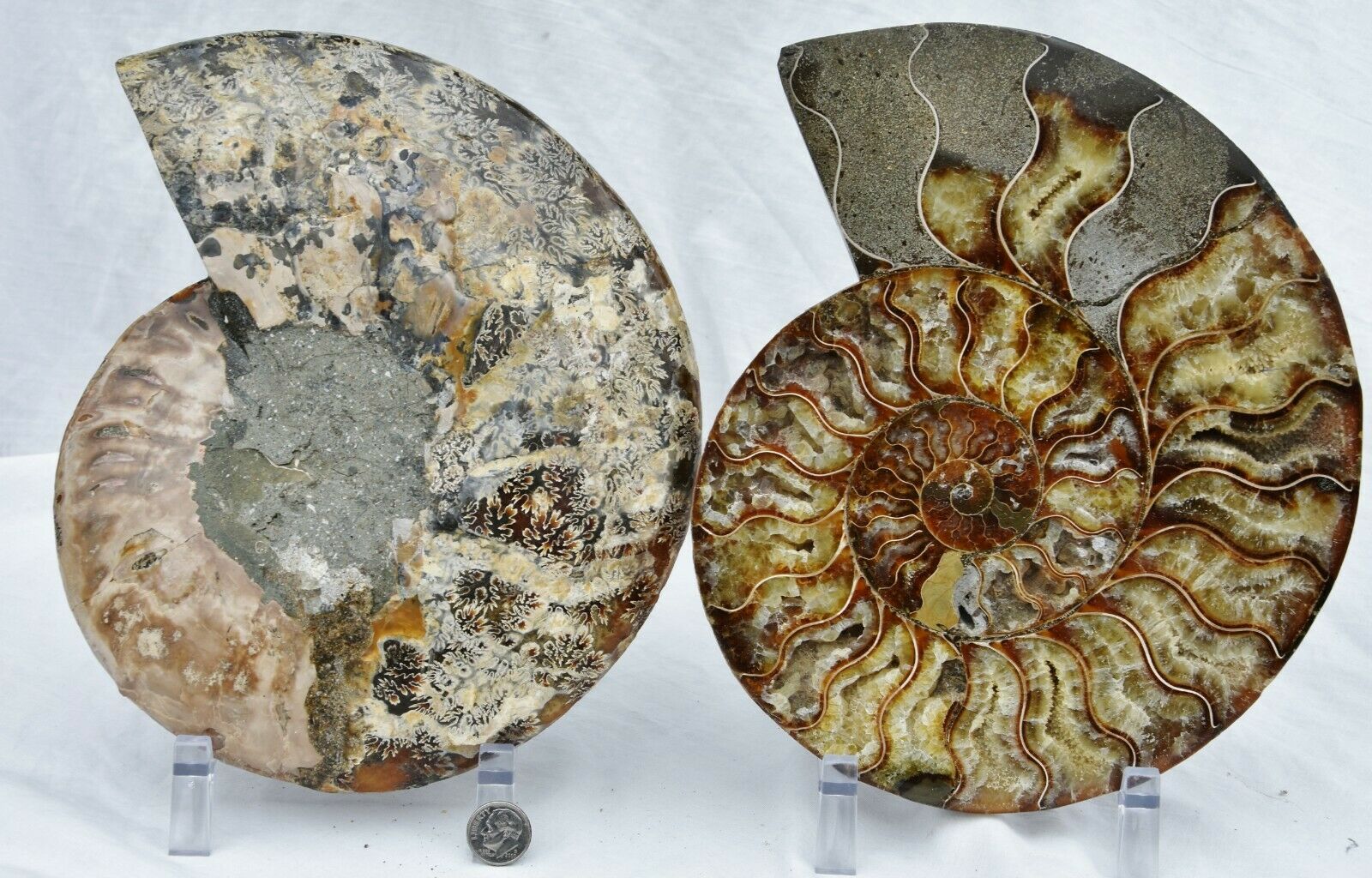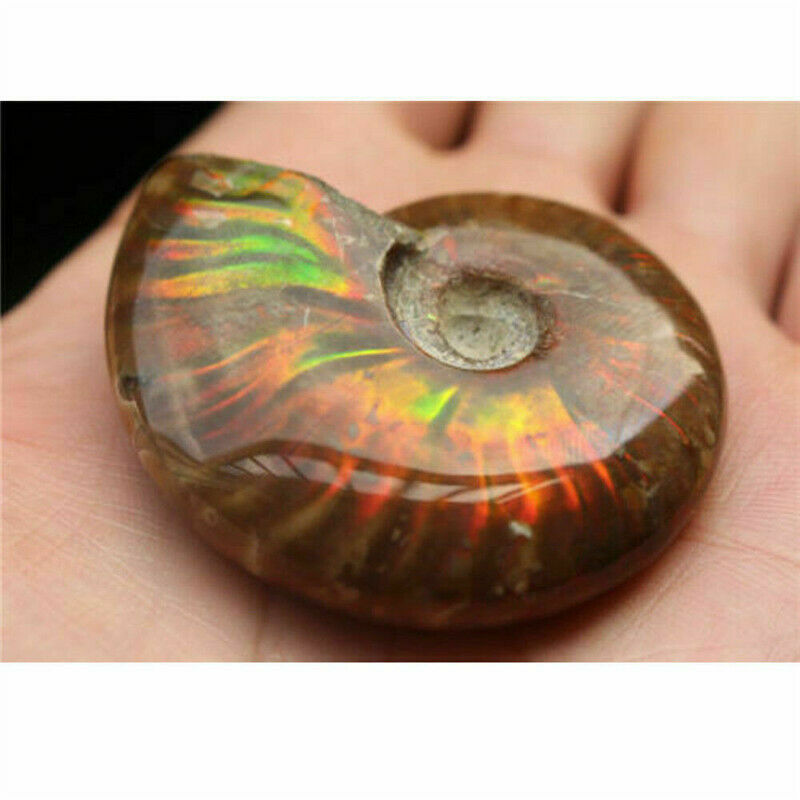-40%
Fossil Cut PAIR Ammonite w/Crystals XXL 8.8" 110 million years old 222mm 3482uu
$ 139.38
- Description
- Size Guide
Description
Imagine holding in your hand a 110 million year old fossil. Some ammonites are much older than that, up to 450 million years old. Even older than the dinosaurs. Oceans at the time were teeming with life. Predators were everywhere. And it was a live fast, or die hard world for the ammonites. In fact, ammonites closely resemble modern squids, octopus and the chambered nautilus. Ammonites were carnivores as well.Fossils were
once
found only in museums - NOW you can OWN one!!! You can hold in your hand a part of the ancient fossil record from the time the dinosaurs roamed the earth.
This is the NEW batch from Madagascar. I brought in for Tucson with some of the best color and deepest cavities/pockets around, excellent batch!!! Super nice crystals, absolutely the best I have seen in years.
Description: Ammonite Pair Split, Cut and Polished
Weight (lbs): 4.6#
Weight (gm): 2070 grams
Size (inches): 8.8" x 7.25"
Size (mm): 222 mm x 184 mm
Mine location: Tulear, Madagascar
Item Number: 3482 y 78
Retail value: 5
----------------------------------------------------------
Facts about ammonites -
Closest living relative - Octopus, Squid, Cuttlefish and it's closest cousin the Nautilus.
First appeared - in shallow seas 450 million year ago.
Extinct - in a catoclysmic event in the Cretaceous, with the dinosaurs about 65 million years ago.
Began life - less than 1 mm in diameter. About the size of a period in this sentence. But they grew fast.
Females - reported to grow 400% bigger than males.
Shells - comprised of chambers growing as the ammonite did. Making 13 new chambers each year. The ammonite lived in the last section, called the living segment.
Medieval Europe - Ammonites were thought to be petrified snakes. They were called "snakestones" or "serpent stones". Ammonites were said to be evidence for the actions of St. Hilda and St. Patrick - who drove the snakes out of Ireland. In ancient times, traders would carve the face of a snake into the wide end of the ammonite fossil and sell them to the public.
The name Ammonite - comes from their spiral shape. The fossilized shells somewhat resembled tightly coiled rams' horns. Pliny the Elder (79 A.D. near Pompeii) called these fossils - ammonis cornua ("horns of Ammon") . Because the Egyptian god Amman was typically depicted wearing ram's horns.
-----------------------------------------------
Types of ammonites -
Cleoniceras
- These most colorful ammonites come from Madagascar, off the coast of Africa. Cleoniceras is the most common type in Madagascar. 99% of the ammonites found in Madagascar are this species, with a smooth shell and angled segments. The animal actually lived in the very last segments. Variations in price are due to color differences and how many crystal cavities (or open 'cave like' structures) in the segments. On average 110 million years old.
Cymatoceras
- Wide body Madagascar ammonites. Some stand on their own and do not need stands. Much rarer than the regular narrow body Cleoniceras. More like a Wide Body Nautilus.
(Limited quantities)
Perisphinctes
- Less than 1% of Madagascar ammonites are this type. Ridges are on the back with a complete different growth pattern. The chambers are also more compact and of a different shape. Frequently one of the most brightly colored. On normal ammonites, the middle is thicker. On Perisphinctes the inner coils are smaller which is a rare occurance among ammonites. These always command a high price. (
RARE
)
Fire ammonites
- Also from Madagascar. Notoriously hard to photograph. Fire ammonites have a gorgeous jewel red flash to them. In fact this jewel red flash is so hard to photograph that we have to take over 100 pictures, just to get 10 good photos. Similiar to opals in their brilliance. Occasional flashes of blue, green and purple can be seen. Fire ammonites look much better in person than in the photograph. (
LIMITED QUANTITY
)
Rainbow iridescent
- Running from blue to white in base color, iridescents have a multiple color personality all their own. These are hard to photograph as well. Stunning blue, green, red and pink can be seen as they are moved in the light. Not as hard to photograph as the FIRE RED, but still hard to photograph. Again these are found in Madagascar only rarely.
(LIMITED QUANTITY
)
ALMOST SOLD OUT!!
Pyrite ammonites
- Pyrite actually replaces the animal shell. A very odd occurance. (Calcite replaces the animal shell in most of the other ammonites.) Pyrite ammonites are species Kosmoceras. Kosmoceras frequently have a opalized shell on the outside. Occasionally this shell is rainbow iridescent. Stunning colors of red, green, blue and other bright colors. In Russia, they use a chemical solution to remove the shell on one-half of the ammonite. This exposed the pyrite segments inside. These are only found in Russia, in the Volga River area. Most are around 165 million years old.
Orthoceras
- Straight ammonites from Morocco. Frequently found with round Morocco ammonites called goniatites. About 400 million years old, some of the oldest ammonites. (moderately common) Big ones are rare.
Goniatites
- Curved ammonites from Morocco. Small ones are moderately common. Large ones up to 12" are much rarer and in higher demand as decorator pieces. The reason? The wide ones frequently stand by themselves. Usually grey, black and white in color. Sometimes in earth tones. Goniatites are frequently 400 million years old, some of the oldest ammonites. (small ones moderately common,
large are rarer
- especially ones over 6")
ONLY a few large ones in Tucson, they found very few this year.
UK ammonites
- We occasionally have Rainbow colored (2-3")
Psilocercy
from Dorset England. About 200 million years old. And small black & white
Promicoceras
from Lyme Regis, Dorset, which rarely exceed 1". We have a few golden black
Dactiloceras
from Whitby, UK. About 165 million years old. (VERY
LIMITED
QUANTITY)
SOLD OUT!!!
On a recent trip to Germany - I was able to acquire a few
Orthosphinctes
from Malm gamma, Bischberg. Nice greenish yellow 2-3" ammonites on matrix. (
LIMITED
QUANTITY)
SOLD OUT!!!
Check our other listings for these and other types of fine ammonites!!!
------------------------------------------------
New Tucson Ammonite finds:
Madagascar:
Anapuzosia
- WIDE Body with D shaped segments inside. (Regular Cleoniceras have S shaped segments) These are from a new areas of Madagascar and I am not sure how much longer they will last. Very deep crystal cavities. (
Limited quantity
)
Phylloceras
- WIDE Body with an odd V shape segment. Also from the new areas of Madagascar. (
VERY Limited
)
Hemitetragonites and Neosilisites
- Both are Medium Body not as wide as Cymatoceras, nor as thin as Cleoniceras. Some where in the middle - Goldielocks would say, "Just right". They are usually presented WHOLE. Unique suture patterns on the outside. And most interesting they have flattened sides. They others are rounded. Really cool, some stand without a stand. (
Very Limited
supply
)
Melchlorites -
Similiar to above but with a cross band on the sides and a rounded shell. Medium body. (
Limited
supply
)
Desmoceras
- A Medium Body Ammonite similiar to the thin Cleoniceras, but wider body with a tighter coil of the shell. Usually with V- Shaped segments. Unlike the Cleoniceras which S-Shaped segments. (
Limited supply
)
Douvilleiceras -
Unusual in that it has a RIBBED back, 145 to 165 million years old. Medium bodied, with "D" shaped segments.
RARE
and sell fast!!!
MOROCCO - Wow did I find some great ones!!!
Shoenbacchia -
These you have to see in person. They have great color and crystal cavities that go all the way through to the OUTSIDE. Madagascar ones do not do that, all the crystals are inside the shell on the Madagascar ones. About 110 million years old, and the crystals are superb. I have carried these before and too be honest, I was disappointed in the sales. I guess the pictures did not do them justice. As they are hard to photograph. I have placed a orange card behind them so you can see throught the crystal cavities to the other side. Okay now I am going to be mean: Since they are low margin and they sell great at shows. I am putting half on eBay and half for shows. If they sell at shows I am pulling the ebay listing. (So get them
while they last
.)
Notoceras -
Odd ribbed shell ones for High Atlas Mountains, Morocco. 1-3" on matrix. A lower priced, but unique ammonite. About 170 million years old. (
Limited quantity)
-------------------------------------------------------
The best I saved for last!!! Back by popular demand.
Heteromorph -
These are the strangest animals around. A long "
J hook
" then a ammonite type shell. At least 117myo. (I am trying to find more research, as I recall reading somewhere that some species could be over 450 million years old and a precurser to the other ammonites.) There is some speculation they also partially buried themselves in the mud and held their tentacles in unique way to feed, thus the shape. This is all speculation.
Normally I only see 18-24" ones that are between 0 and 00. However I found only 10 small ones in the 3-4" range. They are less than 9 and I will NOT take less or offer them on auction. They are priced very fairly especially for the
RARITY.
-----------------------------------------------
Madagascar Ladies Coop - Most ammonites come from Madagascar, off the coast of Africa. Madagascar has all the problems that that the African continent has. One way you and I can combat this is to buy our ammonites from a 'Ladies Coop'. This is where I get my ammonites. Not all dealers buy from this source. We will get to the 'ladies coop' in a minute.
A few facts about Madagascar - Average per capita income is 00 to 53 per year. With an average family size of 6.6.
That makes the average family income in Madagascar ,600 to ,000 per year. Enough for the basics, but not much else.
Imagine
trying to feed
your
family of 6-7 people with only 00 per year?
Madagascar families have hard working people, they don't want a 'hand out'. But folks, we can give them a 'hand up'. The men go out and do the digging and rough surface mining. Hot sweaty, back breaking work. The women at the 'ladies co-op' work together as a team. Splitting or cutting the ammonite down the middle with a diamond saw. Then polishing the inside to a high gloss and then polishing outside to show the shells' true variety. This can take up to 6 hours per ammonite.
Today 90% of the animals on Madagascar are found no where else. Even in ancient times the ammonites of Madagascar's shallow sea were unique. And no other local produces ammonites of such wide ranging colors. Of the affordable ammonites, Madagascar produces the best and most colorful.
Your purchase helps feed a family in Madagascar.
------------------------------------------------------------------------------------------------------------------------
If you want combined shipping PLEASE email us




















